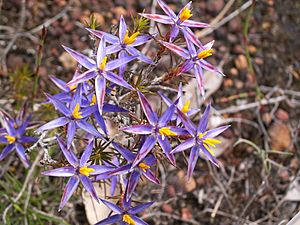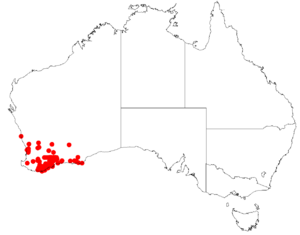Blue tinsel lily facts for kids
Quick facts for kids Blue tinsel lily |
|
|---|---|
 |
|
| C. grandiflora at Mount Barker. | |
| Scientific classification | |
| Genus: |
Calectasia
|
| Species: |
grandiflora
|
 |
|
| Occurrence data from AVH | |
The blue tinsel lily (scientific name: Calectasia grandiflora) is a beautiful plant found only in the south-west part of Western Australia. It's a type of plant that lives for many years and blooms with lovely blue flowers in spring. It belongs to the Dasypogonaceae family.
What it Looks Like
The blue tinsel lily is a perennial herb, which means it's a plant without a woody stem that lives for more than two years. It grows from an underground stem called a rhizome. This plant can reach about 60 cm (24 in) tall. Its stems have many side branches, and its leaves are small, usually between 5.2 to 16.5 millimeters long and 0.4 to 1.2 millimeters wide.
The flowers have six blue petals. These petals change color to red as they get older. The yellow parts in the center of the flower, called anthers, stay yellow. This is different from some other Calectasia species where the anthers also change color. You can see these flowers from June to October, which is during winter and spring. They tend to bloom a bit earlier in the Perth area compared to the Wheatbelt and Stirling Ranges.
Naming the Plant
Calectasia grandiflora is one of eleven different species in the genus Calectasia. A genus is a group of similar plants. This specific plant was first officially described by a person named Ludwig Preiss in 1846.
The second part of its scientific name, grandiflora, comes from two Latin words: grandis meaning "great" and floris meaning "flower". This name was chosen because its flowers are quite large compared to those of a similar plant called C. narragara. It's commonly known as the blue tinsel lily. Sometimes, people suggest calling it the "large-flowered tinsel lily" to help tell it apart from other plants in the same group.
Where it Grows
The blue tinsel lily grows in the south-western part of Western Australia. You can find it in different types of soil, like sand, sandy clay, gravel, laterite, and even on granite rocks. It likes to grow in wet areas, such as swamps, and also on rocky outcrops, flat lands, slopes, and ridges.
It lives in several different natural areas within Western Australia, including:
- The Avon Wheatbelt
- The Esperance region
- The Geraldton Sandplains
- The Jarrah Forest
- The Mallee region
- The Swan Coastal Plain
- The Warren region
Is it Endangered?
Good news! The blue tinsel lily is currently not considered a threatened plant species.
See also
 In Spanish: Calectasia para niños
In Spanish: Calectasia para niños

